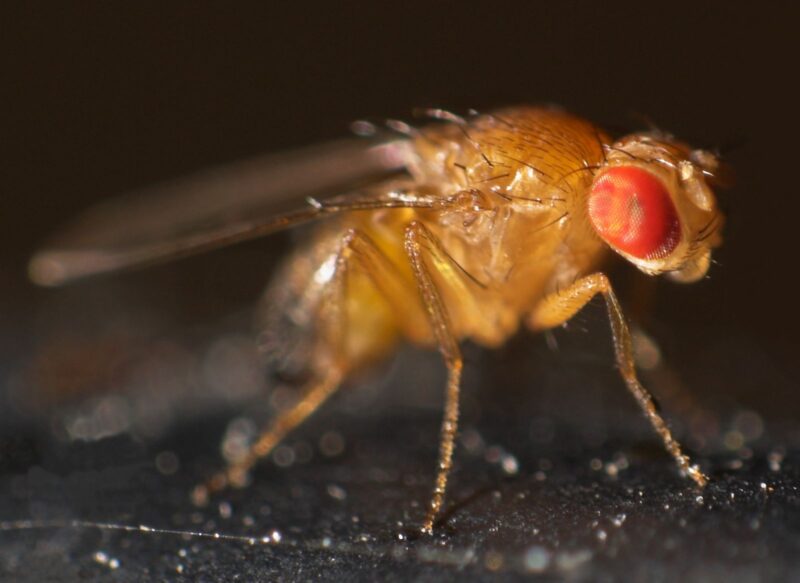
In caves around the world, animals and other creatures have adapted to endless night. Cavefish, for example, have lost their eyes and pigment, evolving a greater power in other senses.
In 1954, Syuichi Mori, a biologist at Kyoto University, put flies into a cave of their own. He took eggs from ordinary flies of the species Drosophila melanogaster put them in milk bottles, which he placed in pots and covered in dark cloth. There they lived in utter darkness. He tended to the flies, generation after generation, dividing them into three separate lines. Meanwhile, he reared three lines of flies in normal light for comparison.
Raising flies is not an easy business. They can pick up infections and die in droves. Over the years, all the normal lines of flies died out, as did two of the dark-bred flies. But Mori managed to keep the last line of flies alive in the dark, and after his death, other Kyoto researchers kept the flies going. And today, they are still living in the dark, 57 years since their ancestors last saw light. That’s 1400 generations–which would be some 30,000 years if it were humans living in dark.
Keeping organisms in such weird conditions is one of the most interesting ways to learn about evolution. Scientists create a set of conditions and then allow organisms to grow, breed, and mutate. Mutations that let some individuals survive better and have more offspring become more common in the population due to natural selection. Other mutations can spread thanks to the luck of the genetic dice.
Mori wondered what sort of changes would occur in his dark flies. Would they lose their internal clock, controlling the daily cycles of their bodies? Would they stop responding to light? Would they evolve in other, unexpected ways?
In some respects, the flies haven’t changed much. They still have normal eyes, for example, complete with pigments. Last year, Michio Imafuku and Takashi Haramura reported that the dark flies still had their body clock. If they exposed the flies to three and a half hours of light, the insects became active and sluggish in a 24-hour cycle.
But the Japanese scientists have also found some differences. The bristles on the dark flies became unusually long, for example.
That change might simply be a fluke of rearing flies from a few related insects. To find out if the flies had experienced natural selection, Naoyuki Fuse and colleagues applied modern technology to this venerable invertebrate dynasty.
As they report in PLOS One, there are some tantalizing clues that the flies have indeed adapted to life in the dark.
For starters, the researchers observed how well the flies reproduced. After all, that’s what natural selection is all about. They counted up the eggs that the flies laid, either in the dark or the light, and compared their success to their ordinary relatives. The researchers found a major difference: when kept in the dark, dark-bred flies laid 373 eggs, plus or minus 20. Ordinary flies laid 293 eggs, plus or minus 73. Somehow, in other words, the dark-bred flies had become better at breeding in the dark.
To start hunting for the cause of this change, the Kyoto researchers sequenced the genome of the dark-bred flies and compared it to a genome from normal relatives. They found 220,000 spots in the genome where the DNA had mutated (a single nucleotide polymorphism). In addition, there were 4700 places where a stretch of DNA had been inserted or deleted.
A lot of those mutations may not have had any effect on the flies. So the researchers began to sift through the changes for ones that had good evolutionary potential. They found some promising candidates. For example, a gene for a light receptor had acquired a particularly devastating change called a nonsense mutation, which prevents the fly from making a functioning protein. A gene involved in metabolism disappeared. Once the flies were cast into darkness, flies without these proteins may have done better than the ones that held onto them.
The scientists also looked for stretches of DNA that showed signs of having experienced natural selection. Each fly carries two copies of each chromosome, and each chromosome is sprinkled with its own set of mutations. Here and there, however, the DNA on the chromosomes is identical. This close matching is sometimes the result of genes spreading quickly through a population thanks to natural selection. The scientists found 241 new mutations in these identical stretches–potentially giving the flies an advantage in the dark. One of those genes is involved in breaking down toxins. The scientists speculate that flies ordinarily use light to help break down toxins. The dark flies may have evolved a way to do so without the light.
Perhaps Mori envisioned his flies becoming like cavefish, pale and blind in their bottles. That didn’t happen. But now scientists can probe his flies far more deeply, reading their entire genome. And while they may not show obvious signs of evolution, subtler ones may be present by the hundreds.
Originally published March 14, 2012. Copyright 2012 Carl Zimmer.